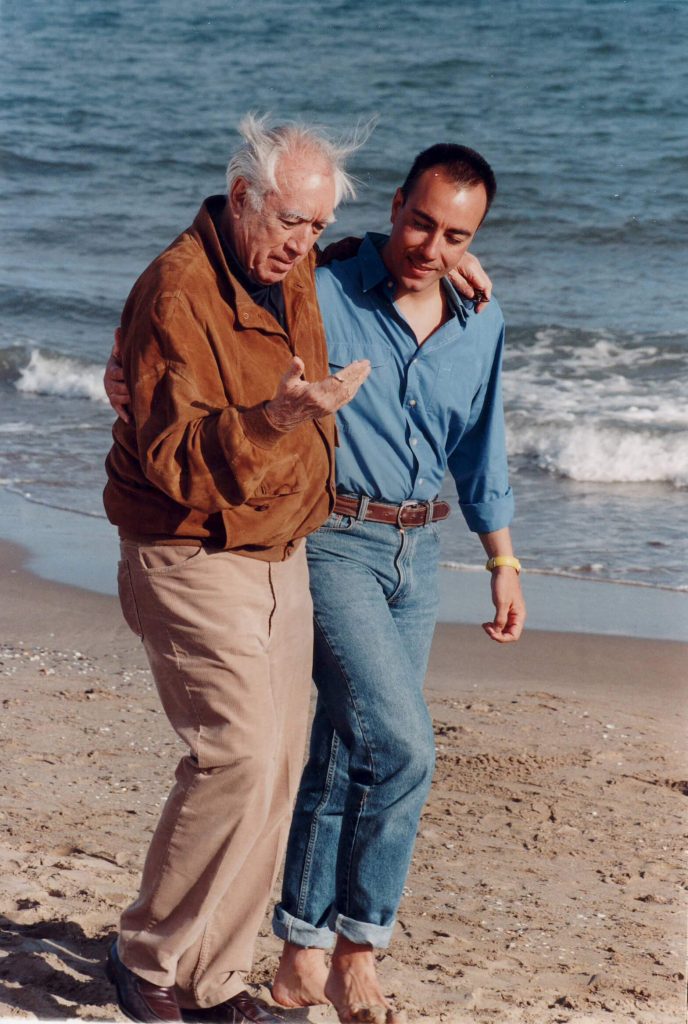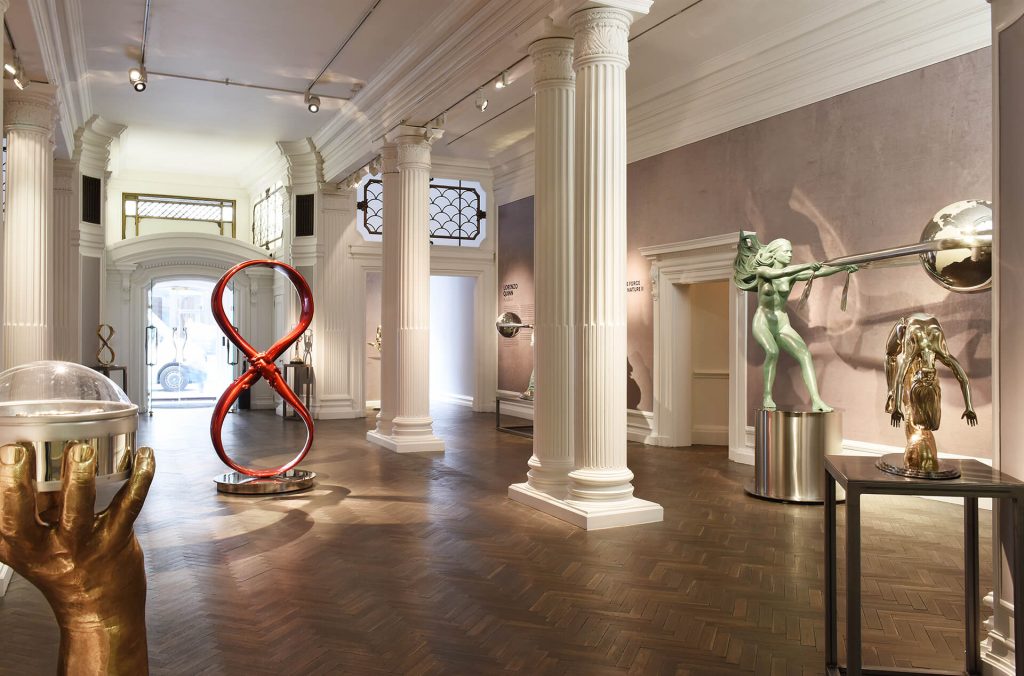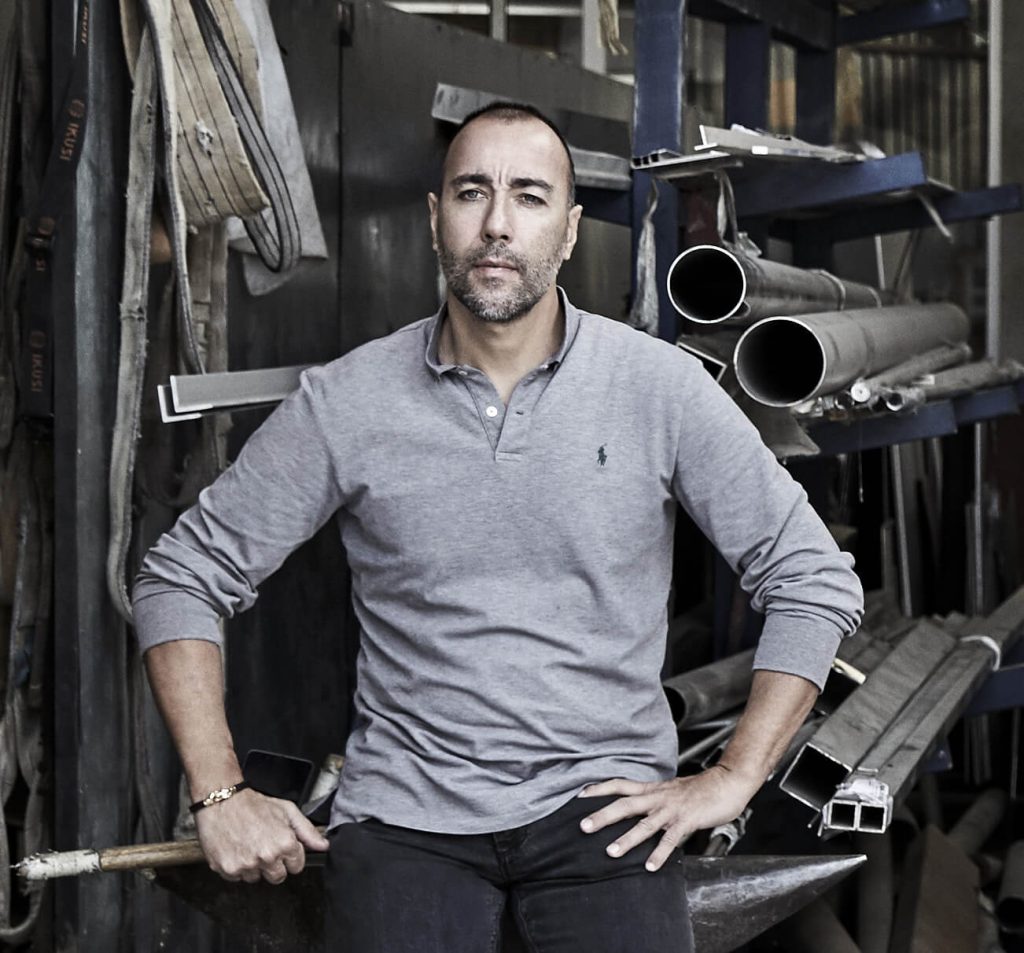Large format sculptures in public spaces are viewed by people from all walks of life. While the attempt may be to add beauty and character with such ‘intervention’, it is important that the man on the street is easily able to relate to it. Anything esoteric will only alienate the uninitiated viewer, eventually defeating the very purpose of it all. Artist Lorenzo Quinn keeps this understanding at the forefront for his monumental three-dimensional works. Quinn began his artistic life as a painter. And though a small presentation of a few surrealistic paintings was very successful (he sold all of them), he expanded his oeuvre to sculpting. “The owner of the gallery said that she saw my paintings felt as though there was a need for the third dimension,” he says.
Lorenzo Quinn in his studio
Image: Lorenzo Quinn
I speak with Lorenzo Quinn on his work, philosophy, and how after over two decades of the passing of his father, the celebrated actor and artist Anthony Quinn, the question of expectations still persists for him.
Rahul Kumar (RK): Your laborious process and command on the craft to produce large-scale public sculptures are undeniable. The use of human hand is a recurring motif in the large-scale works. While it is universally recognised, what is your intent to place them in unexpected locations?
Lorenzo Quinn (LQ): I think artwork should be experienced, at times in different ways than we are usually used to experiencing them…in the sense that I think people should interact with art. I am trying to share with a specific work of art that I exhibit a certain message. I use hands because hands are a universal way of communicating. Everybody understands hand gestures. If say I were to use human bodies, perhaps I would not have the same success because in many countries you cannot exhibit naked figures, while hands are accepted universally.
Together, a stainless-steel wire sculpture with over 35000 welding points. It weighs 600 kgs
Image: Lorenzo Quinn
RK: Most of your work is classical in nature, with precise replication of easily recognisable forms. And yet, the context you place them in is very contemporary. How according to you should your practice be positioned in the current times?
LQ: That is a very good observation. And yes, that is what actually I try to do. So, I am happy it comes across. I am a great lover of the classical masters. You could say the more academic artist practices. But of course, we do live in the year 2021 and we have to be coherent with our times. So yes, I try to contemporise the academic forms, which is not easy because a hand today was as it was 500 years ago during the Renaissance. I try using different materials, using different sets, and scaling the hands differently. I think that use of technology can help us do that. So, most of my large sculptures are made specifically for a site. I make quite a few large installations and permanent placements where I travelled to the location, study it, and I see what may be the best way to place them and at the same time transmit that message. This for me is very important.
Support QualityImage: Lorenzo Quinn
RK: Please tell us about your childhood and upbringing; when did you begin to realise that your father, Anthony Quinn, is a celebrated Hollywood actor? Was there ever a pressure for you to succeed as an artist?
LQ: Well, the thing that you are asking, and the very fact that you are asking me this question already proves that you will not ask another artist this same question…you would just ask them about their artwork. I have been working as an artist for 35 years. My father passed away 20 years ago. And I still have to answer this question. Of course, I am very proud of what my father has achieved. But I have my own life and my own career to think about. And I have been supporting myself as an artist practically since the beginning. So yes, it is difficult sometimes because there is always a pre-conceived notion of who I am.
Lorenzo with his father Anthony Quinn
Image: Lorenzo Quinn
It is not easy. If you think about it, any famous person that is not born from another famous person, he has the benefit of making mistakes. And those mistakes are not public because nobody is judging them, because they do not come from an important family. Since the beginning, people were looking at me under magnifying glass and saying, ah, let’s see if he can stand up to what his father has done. Anyway, to answer the other question, when did I realise that my father was famous? Uh, well, I was brought up in Los Angeles (USA) ). I was six-years-old then. Later we moved to Rome (Italy), and we lived in the countryside. But in LA we lived on the street called St. Claude and our neighbour to the right was John Wayne, and our neighbour to the left was Kurt Douglas. Three homes down there was Paul Newman, further down there was Henry Fonda, across the street we had Jerry Lewis. So, that was our neighbourhood. But of course, as a four, five or six-year-old kid, you don’t realise it. And then when I moved to Italy and we went into the countryside and my neighbour was the farmer. I kind of realised it was a bit different.
RK: You have yourself acted in films, and went on to train as a surrealist painter. What lead you to take a departure into three-dimensional format?
LQ: Actually, it was the gallery owner with whom I had my first exhibition in 1986 in Honolulu. Thanks to my father that he was doing a very big show, a lot of people don’t know, but my father was a quite successful painter and sculptor, especially towards the end of his life. He was actually more successful as a sculptor and painter than he was as an actor…but just that’s how Hollywood works, unfortunately. So, he had a very big show and he offered me a room to exhibit my paintings. And I just had a few paintings, I think I had seven or eight paintings and I sold them all. People enjoyed it, but they were all priced for $400-500. I think the most expensive was priced at $900. So, they were quite affordable. They were very surrealistic, because I was incredibly fond of Salvador Dali. So, I tried to copy him. Of course, ‘tried’ to copy him. That’s the key word, because that league nobody can copy. The owner of the gallery said that she saw my paintings felt as though there was a need for the third dimension. She asked, “Why don’t you try sculpting? And since you paint a lot of hands, try a hand sculpture”. And so, I did that and I never stopped.
RK: Some of your most famous works are monumental in scale. While they allow for a viewership by the common man, are there works that you believe must remain in a diminutive scale for an intimate viewing?
LQ: I have not done that on purpose. Some of them you just cannot scale up for whatever reason it might be… at times it is impossible to do at a bigger scale because of gravity. Just the engineering of these would be impossible to make bigger and larger scale or will end up very costly. But I would love to make all of my sculptures at a larger scale. In fact, some of them exist on a large scale and do not exist in a smaller one.
Display at Halcyon Gallery – London
Image: Lorenzo Quinn
RK: Lastly, there are references to mythology and spiritual philosophy in your sculptures, for instance in Adam and Eve you talk about the essence of the feminine and the work titled Choices examines the impact of emotions on individuals. How important it is for you to have your audience relate to those references, especially in case of your publicly displayed works that may be seen by a wide spectrum of viewers from varied walks of life?
LQ: Well, I think it is fundamental. I think it is very important that my work relates to that. I try to choose, especially for the public work, I try to choose a universal theme so that we can all relate to them. Many, many years ago, I used to make my figures faceless. I do not have to do that because really what I want is that everybody can see themselves reflected in that artwork and that art piece. So, I did the sculpture faceless so that everyone can identify with it. I studied philosophy in New York University and I read a lot on philosophy, something I love and still do today. And that is one of the main sources of inspiration for me, and also mythology. Greek mythology, and later even Roman mythology. In fact, I want to do a series about that, but I have to find a contemporary twist to it. So that is what I am working on.
Lorenzo Quinn
Image: Lorenzo Quinn









